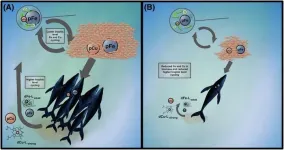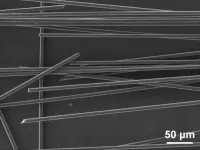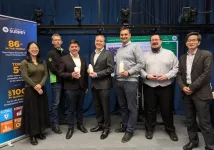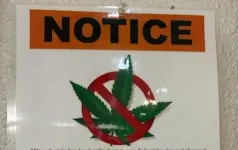(Press-News.org) The blue whale is the largest animal on the planet. It consumes enormous quantities of tiny, shrimp-like animals known as krill to support a body of up to 100 feet (30 meters) long. Blue whales and other baleen whales, which filter seawater through their mouths to feed on small marine life, once teemed in Earth’s oceans. Then over the past century they were hunted almost to extinction for their energy-dense blubber.
As whales were decimated, some thought the krill would proliferate in predator-free waters. But that’s not what happened. Krill populations dropped, too, and neither population has yet recovered.
A recent theory proposes that whales weren’t just predators in the ocean environment. Nutrients that whales excreted may have provided a key fertilizer to these marine ecosystems.
Research led by University of Washington oceanographers supports that theory. It finds that whale excrement contains significant amounts of iron, a vital element that is often scarce in ocean ecosystems, and nontoxic forms of copper, another essential nutrient that in some forms can harm life.
The open-access study, the first to look at the forms of these trace metals in what’s commonly known as whale poop, was published in January in Communications Earth & Environment.
“We made novel measurements of whale feces to assess how important whales are to recycling important nutrients for phytoplankton,” said first author Patrick Monreal, a UW doctoral student in oceanography. “Our analysis suggests that the decimation of baleen whale populations from historical whaling could have had larger biogeochemical implications for the Southern Ocean, an area crucially important to global carbon cycling.”
The Southern Ocean encircling Antarctica harbors little human life but is thought to play an important role in the global climate. Strong circumpolar currents bring deep ocean water up to the surface. Huge blooms of plant-like organisms known as phytoplankton support populations of krill, which are still harvested in unprotected waters today for aquaculture and pet food.
To investigate what role whale poop may have played in this ecosystem, the study analyzed five stool samples. Two samples were from humpback whales in the Southern Ocean and three were from blue whales off the central Californian coast. The samples were collected when researchers out studying whale populations saw an opportunity.
“The nice thing, I guess, is that whale excrement floats,” said senior author Randie Bundy, an assistant professor of oceanography at the UW. Researchers collect it using a net attached to a jar to collect the substance typically found as a slushy or slurry material.
“The hypothesis is that the whales were actually adding nutrients to the ecosystem that these phytoplankton were able to use, so they would bloom more and then the krill could eat them,” Bundy said.
Previous research had found significant amounts of major nutrients, like nitrogen and carbon, in whale poop samples. The new paper instead looked for metals that are in short supply far from land and are often a limiting factor for the growth of ocean ecosystems.
“In the Southern Ocean, iron is considered to be one of the most scarce, or limiting, nutrients that phytoplankton need to survive,” Bundy said
Results showed iron was present in all the samples. The researchers also found another metal, copper.
“We were really shocked by how much copper was in the whale poop. We initially thought, ‘oh, no, is the whale poop actually toxic?’” Bundy said.
Further analysis showed that organic molecules known as ligands attached to the copper atoms transformed them into a form that is safe for marine life. Other ligands helped make the iron accessible to living organisms. The researchers don’t yet know the source of the ligands but suspect they may come from bacteria in the whales’ stomachs.
Bundy’s research focuses on trace metals in the ocean environment. This project began as Monreal’s introductory research project as a graduate student but it grew into a larger endeavor as the results came in.
“I think animals play a larger role in chemical cycles than many experts give them credit for, especially when thinking at the ecosystem scale,” Monreal said. “When I say animals, I really mean their gut microbiome. Based on what we see, it seems like bacteria in the whales’ guts could be important.”
Co-authors are postdoctoral researcher Angel Ruacho, former doctoral student Laura Moore and former undergraduate student Dylan Hull from the UW; Matthew Savoca and Jeremy Goldbogen at Stanford University; Lydia Babcock-Adams at Florida State University; Logan Pallin, Ross Nichols and Ari Friedlaender at the University of California, Santa Cruz; John Calambokidis at the Cascadia Research Collective in Olympia, Washington; and Joseph Resing at the National Oceanic and Atmospheric Administration and the UW’s Cooperative Institute for Climate, Ocean and Ecosystem Studies. Funders are MAC3 Impact Philanthropies, the MUIR Program at the Stanford Woods Institute for the Environment, the University of Washington Program on Climate Change and the Ford Foundation.
For more information, contact Monreal at pmonreal@uw.edu and Bundy at rbundy@uw.edu. Note: Monreal is on New Zealand time through mid-February and responses may be delayed.
END
Whale poop contains iron that may have helped fertilize past oceans
2025-02-06
ELSE PRESS RELEASES FROM THIS DATE:
Mercury content in tuna can be reduced with new packaging solution
2025-02-06
Fish is a high-quality source of protein, containing omega-3 fatty acids and many other beneficial nutrients. However, the accumulation of toxic mercury also makes fish consumption a concern, of which tuna is particularly susceptible. Researchers from Chalmers University of Technology in Sweden have come up with a novel approach to packaging canned tuna infused in the water-based solution of amino acid cysteine. It was shown to remove up to 35 percent of the accumulated mercury in canned tuna, significantly reducing human exposure to mercury via food.
Fish and other seafood, provide people with a broad variety of essential nutrients in their diet However, the consumption ...
Recycling the unrecyclable
2025-02-06
Epoxy resins are coatings and adhesives used in a broad range of familiar applications, such as construction, engineering and manufacturing. However, they often present a challenge to recycle or dispose of responsibly. For the first time, a team of researchers, including those from the University of Tokyo, developed a method to efficiently reclaim materials from a range of epoxy products for reuse by using a novel solid catalyst.
There’s a high chance you are surrounded by epoxy compounds as you read this. They are used in electronic devices due to their insulating ...
Alien ocean could hide signs of life from spacecraft
2025-02-06
Searching for life in alien oceans may be more difficult than scientists previously thought, even when we can sample these extraterrestrial waters directly.
A new study focusing on Enceladus, a moon of Saturn that sprays its ocean water into space through cracks in its icy surface, shows that the physics of alien oceans could prevent evidence of deep-sea life from reaching places where we can detect it.
Published today (Thursday, 6 February 2025) in Communications Earth and Environment, the study shows how Enceladus's ocean forms distinct layers that dramatically slow the movement of material ...
Research unveils new strategies to tackle atrial fibrillation, a condition linked to stroke and dementia risks
2025-02-06
A recent Brazilian study published in Nature Cardiovascular Research has highlighted promising pathways for preventing and treating atrial fibrillation, a condition that significantly raises the risks of stroke and dementia. The research was led by the Federal University of Rio de Janeiro (UFRJ) in partnership with the D’Or Institute for Research and Education (IDOR).
What Is Atrial Fibrillation?
Atrial fibrillation (AF) is the most common cardiac arrhythmia worldwide. It disrupts the normal rhythm of the heart, causing irregular and often rapid heartbeats. This condition is associated with increased risks of stroke, dementia, and heart failure. It is also linked to other health ...
Research spotlight: Researchers identify potential drug targets for future heart failure therapeutics
2025-02-06
How would you summarize your study for a lay audience?
Heart failure remains a substantial burden for patients due to its high prevalence and limited therapeutic options. Heart failure is classified into two major clinical subtypes— heart failure with preserved ejection fraction (HFpEF) and heart failure with reduced ejection fraction (HFrEF). While there have been significant therapeutic advances in HFrEF, the rate of complications and death from HFrEF remains high. Additionally, most drugs that have shown benefits for patients with HFrEF have not demonstrated a comparable benefit in patients with HFpEF, highlighting a critical need for the development of targeted therapies ...
Air pollution clouds the mind and makes everyday tasks challenging
2025-02-06
People’s ability to interpret emotions or focus on performing a task is reduced by short-term exposure to particulate matter (PM) air pollution, potentially making everyday activities, such as the weekly supermarket shop, more challenging, a new study reveals.
Scientists discovered that even brief exposure to high concentrations of PM may impair a person’s ability to focus on tasks, avoid distractions, and behave in a socially acceptable manner.
Researchers exposed study participants to either high levels of air pollution - using candle smoke - or clean air, testing cognitive abilities ...
Uncovering how developmental genes are held in a poised state
2025-02-06
Key points:
Researchers from the Voigt lab have extended our understanding of how developmental genes are held in a poised state to allow timely expression once they receive the correct ‘go’ signals.
The next layer of regulation has been uncovered by the identification of proteins that interact with the epigenetic marks that poise developmental genes ready for expression.
The research provides insight into the mechanisms through which the phenomenon of bivalency – where both activating and repressive marks are laid down at the same site on the genome – acts to ready developmental ...
Multimillion-pound research project aims to advance production of next-generation sustainable packaging
2025-02-06
A multimillion-pound research project, called SustaPack, aims to overcome manufacturing challenges for the next generation of sustainable, paper-based packaging for liquids. Backed by a £1 million grant from the Engineering and Physical Sciences Research Council (EPSRC) as part of UKRI’s co-investing programme, packaging technology company Pulpex Ltd has joined forces with the University of Surrey to refine its manufacturing processes to provide a viable solution to plastic pollution.
Contributing matching support towards the project, Pulpex has already made significant strides in the development of its patented technology, ...
‘Marine Prosperity Areas’ represent a new hope inconservation
2025-02-06
Could 2025 be the year marine protection efforts get a “glow up”? According to a team of conservation-minded researchers, including Octavio Aburto of UC San Diego’s Scripps Institution of Oceanography, the moment has arrived.
In a new study published Feb. 6 in the journal Frontiers in Marine Science, Aburto and a multinational team of marine scientists and economists unveil a comprehensive framework for Marine Prosperity Areas, or MPpAs. With a focus on prosperity—the condition ...
Warning signs may not be effective to deter cannabis use in pregnancy: Study
2025-02-06
PISCATAWAY, NJ – Warning signs at dispensaries about the potential health effects of cannabis use in pregnancy may not be effective, according to a new report in the Journal of Studies on Alcohol and Drugs, based at Rutgers University. In fact, those who are pregnant and using cannabis may actually distrust the content of warning signs altogether.
“Mandatory warning signs aren’t working,” says lead researcher Sarah C. M. Roberts, DrPH, of the University of California, San Francisco. In fact, some of the respondents “saw the signs as having stigmatizing or negative effects on pregnant people who use ...








